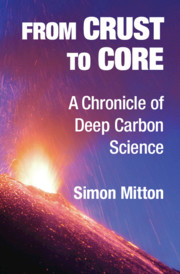Book contents
- From Crust to Core
- From Crust to Core
- Copyright page
- Dedication
- Contents
- Foreword
- Acknowledgments
- Introduction
- 1 Why Carbon in Earth Matters
- 2 The Origin of Deep Carbon in Deep Space
- 3 Deliveries of Cosmic Carbon Continue
- 4 On the Nature of Earth’s Interior
- 5 Earth’s Physical Interior Revealed
- 6 Thousands, Millions or Billions
- 7 Physics and Chemistry of Deep Earth
- 8 Confronting the Continental Drift Conundrum
- 9 The Mid-Atlantic Ridge and Rift Valley
- 10 Earth’s Deep Dynamics Discovered
- 11 Reversals of Fortune
- 12 Deep Carbon
- 13 Carbon-Bearing Phases in the Mantle
- 14 Diamond in the Mantle
- 15 Deep Life
- Glossary
- Biographical Notes
- Index
- References
9 - The Mid-Atlantic Ridge and Rift Valley
Published online by Cambridge University Press: 19 December 2020
- From Crust to Core
- From Crust to Core
- Copyright page
- Dedication
- Contents
- Foreword
- Acknowledgments
- Introduction
- 1 Why Carbon in Earth Matters
- 2 The Origin of Deep Carbon in Deep Space
- 3 Deliveries of Cosmic Carbon Continue
- 4 On the Nature of Earth’s Interior
- 5 Earth’s Physical Interior Revealed
- 6 Thousands, Millions or Billions
- 7 Physics and Chemistry of Deep Earth
- 8 Confronting the Continental Drift Conundrum
- 9 The Mid-Atlantic Ridge and Rift Valley
- 10 Earth’s Deep Dynamics Discovered
- 11 Reversals of Fortune
- 12 Deep Carbon
- 13 Carbon-Bearing Phases in the Mantle
- 14 Diamond in the Mantle
- 15 Deep Life
- Glossary
- Biographical Notes
- Index
- References
Summary
A fundamental goal of geophysics is the construction of a comprehensive understanding of the structure and dynamics of Earth’s interior, which is inaccessible to direct measurement. Therefore, indirect methods such as the interrogation of seismic data obtained at the surface are used to model the physical properties of the interior. Interpretation of data requires the researcher to solve an inverse problem. In scientific inquiry, the solution of an inverse problem requires interpretting data to discover underlying causes. When we ask, “Why is it raining today?” we are posing an inverse problem: we have the data (getting wet!) and want to know the cause (frontal system, thunderstorm, etc.). The reverse situation – posing a forward problem – is to ask, “Will it rain tomorrow?” This can be tackled by computing a forecast from an atmospheric model. This chapter outlines an important case history in which the mere acquisition of data for its own sake led to a fascinating inverse problem: Why is the longest and greatest mountain range on Earth in the middle of the oceans?
- Type
- Chapter
- Information
- From Crust to CoreA Chronicle of Deep Carbon Science, pp. 167 - 193Publisher: Cambridge University PressPrint publication year: 2020



